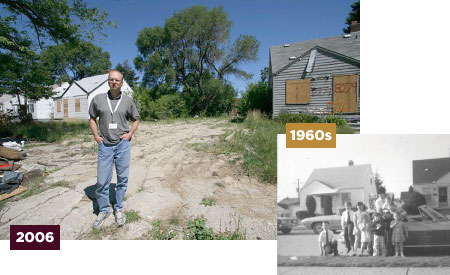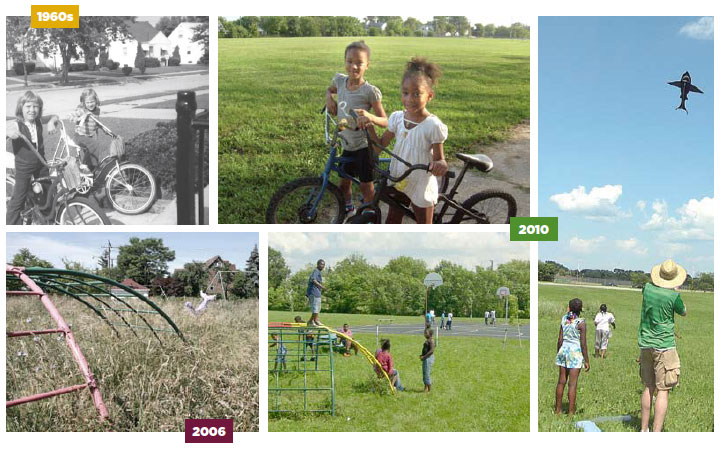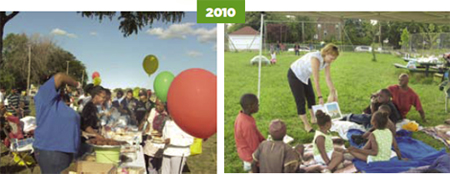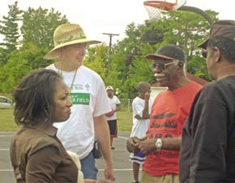Building a Neighborhood Not Bounded by Geography
- Jonathan S. Morgan
- Doctoral Candidate
- Department of Media and Information Studies
- College of Communication Arts and Sciences

Mike Happy on Dobel Street in 2006 (left) and in the 1960s (below).
Mike Happy wasn't happy.
The year was 2006. Happy had recently been hired as an online editor by the Detroit News and was trying to convince his friend and former colleague, Jonathan Morgan, to apply for a job there as well. The two had previously worked together at the New York Times online division.
"I came to Detroit for a visit and Mike took me around to the neighborhood where he grew up," said Morgan. The scene that met them on Dobel Street, on the city's northeast side, was appalling. The neighborhood had been a modest bluecollar suburb in the 1960s and 70s. Now the homes Happy remembered as being filled with children, bicycles, and games were derelict—abandoned, boarded up, covered in graffiti. Fletcher Field, the park where Happy had played ball as a kid, was buried in weeds and trash. The streets were empty of pedestrians. "I could see he was pretty shaken up," said Morgan.
Morgan decided to accept an offer from the Detroit News and the two friends began discussing what to do about Dobel Street. The option of doing nothing did not occur to them.
Blogging Home
"We partnered with the Detroit News neighborhood blog to train citizen journalists to cover their community in an impoverished Detroit neighborhood."
Jane Briggs-Bunting
Not long after that first visit, Happy and Morgan rolled out the "Going Home" neighborhood blog at the News. Their first step was to find out who else cared. "We blogged about fixing up the park and invited former residents to a cleanup and picnic at Fletcher Field. Then we invited them back to a reunion at the local church. Almost a thousand people came. It was amazing," said Morgan.
The blog quickly became the communication hub for the "Friends of Fletcher Field." Since the first summer, said Morgan, the Friends have continued to hold reunions every year, work on and in the park, and recruit more people: "Mike and I are still active but now it's mostly perpetuated by current and former residents. They've reconnected with local businesses and organizations. They're building a network around a location that is not bounded by geography." Current activities include a summer reading program, softball, a community garden, and holiday events.

Full circle: Fletcher Field and the neighborhood today.
More Questions Than Answers
The Fletcher Park project has been a success by any standard. As Happy noted, "People often want to help but they don't know how. 'Going Home' told folks a not-so-happy story and then offered them a solution, a way to assist in changing the ending. The Detroit News is supposed to be the guardian of the city's citizens, ensuring a strong democracy... Unfortunately, as the city shrank over the decades, the focus of the paper turned more toward the suburbs...'Going Home' brought people from both sides of Eight Mile Road back together for a common good...That's how it should be."
But for Morgan, the success of the project led to more questions than answers—questions about how to hold onto the gains of a short-term success.

Friends eat, play, and read at a picnic in Fletcher Park.
Enter Dr. Jane Briggs-Bunting, MSU professor of journalism, and the Tandem Project. "The idea was developed from a Knight Challenge grant," said Briggs- Bunting. "We partnered with the Detroit News neighborhood blog to train citizen journalists to cover their community in an impoverished Detroit neighborhood. Software was created to assist in posting and collecting information. The hope was to replicate this in other areas."
The software developer for the project was Morgan, who holds a bachelor's degree in computer science as well as a master's in journalism. "Jane had the Tandem Project and we had the blog," he said. "At first we just wanted to make it easier for people to participate. Then we hatched a plan to use this way of doing journalism to teach students. We combined efforts and started looking for money."
Rebuilding Social Networks
"We're learning to be smarter about citizen contribution. They're not expected to do it all. They gather the information and the students synthesize it. We create the continuity and get people excited about helping.
We've become a source for people looking to invest in Detroit. MSU could do a lot of good there."
Jonathan Morgan
The two developed a community journalism class and in 2008 they started teaching it at Wayne State University and University of Detroit Mercy. "We had kids out in the neighborhoods, trying to figure out what it took to get a blog started," said Morgan. "At the same time, MSU was adding 300-level community news classes and a capstone 400-level 'virtual newsroom' class to its journalism curriculum. We're still trying to figure out what the learning objectives are. For example, is it better to follow the same neighborhood or switch around? The 400-class students step back and help the 300-level ones. They're starting to build resources for new kids from those who have done it before."
"People often want to help but they don't know how..."
Mike Happy
In the fall of 2008, Morgan enrolled as a Ph.D. student at MSU. His long-term goals include "rebuilding the social networks that used to support local papers, which made for better journalism at the bigger papers also. Jane and I are trying to figure out how to template this and scale it up using students as reporters. The challenge is how to get kids out to work there without doing any damage. They learn accountability—it's live news! Their reports go directly online."
The Tandem Project has been a good start. "We're learning to be smarter about citizen contribution," he mused. "They're not expected to do it all. They gather the information and the students synthesize it. We create the continuity and get people excited about helping.
We've become a source for people looking to invest in Detroit. MSU could do a lot of good there."

Work party at Fletcher Field.

The new sign goes up.

Jonathan Morgan (in straw hat) chats with neighborhood residents at a Fletcher Field event.
- Written by Linda Chapel Jackson, University Outreach and Engagement